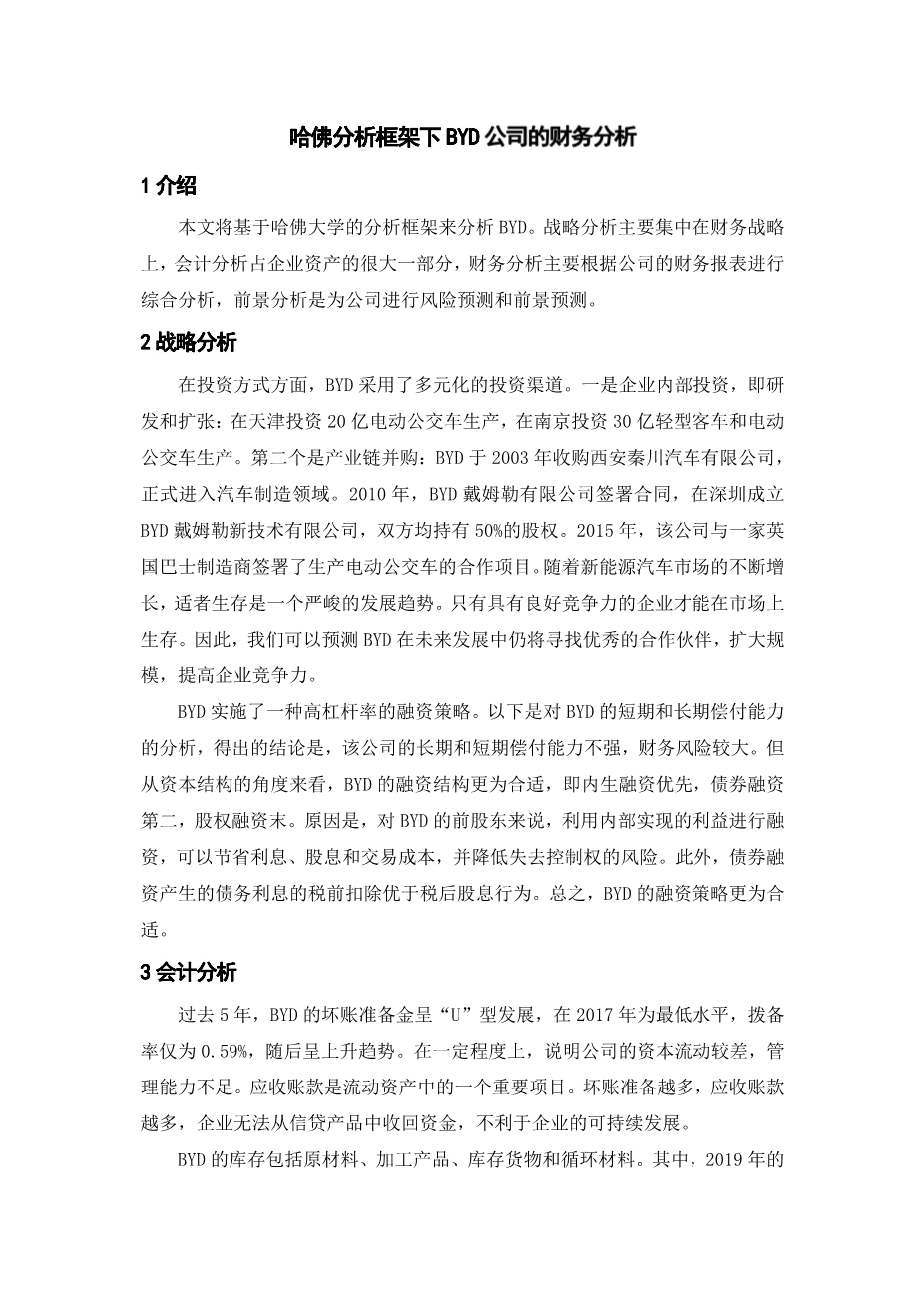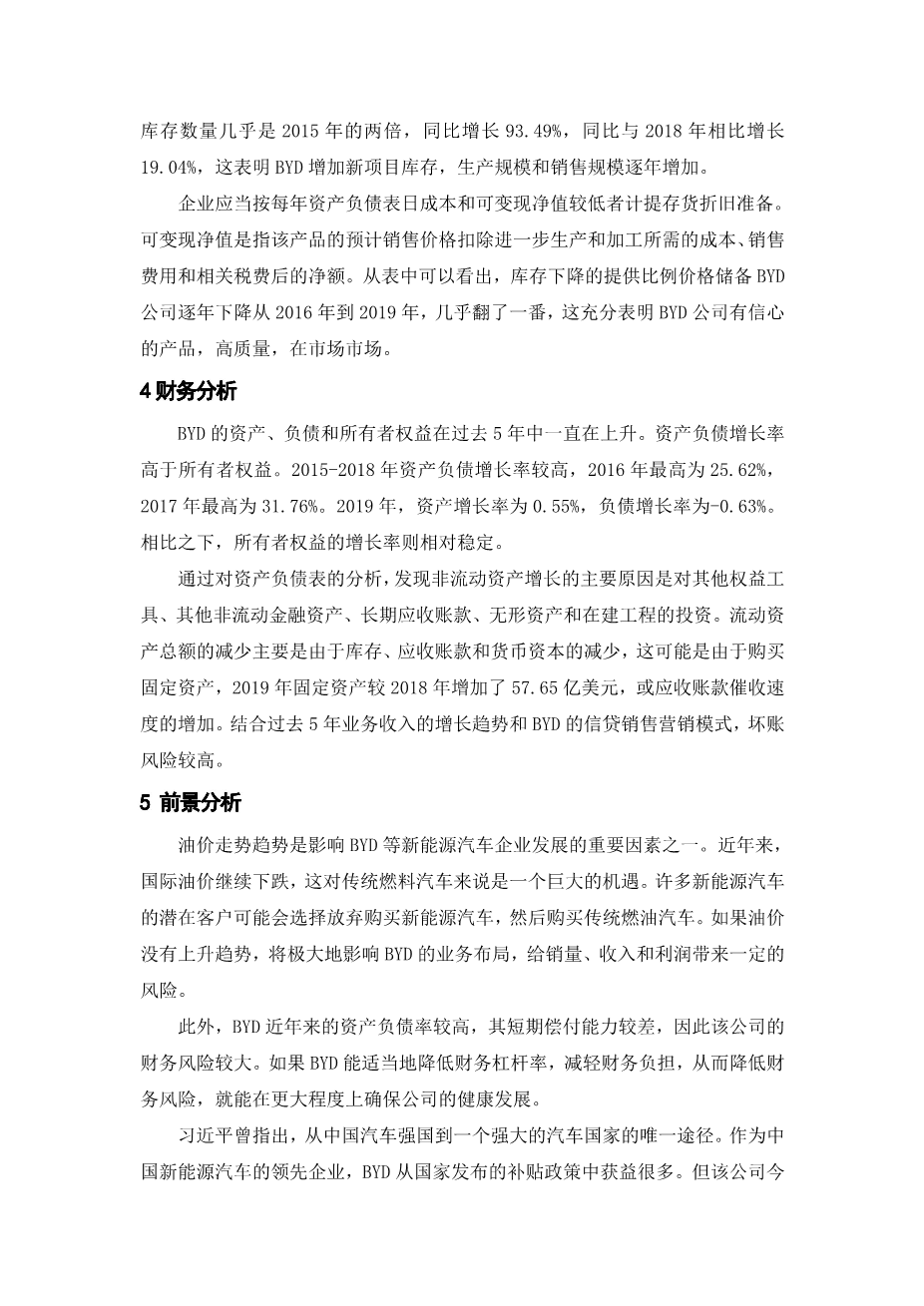Financial analysis of BYD Company under the framework of Harvard Analysis Meng XIE
1 Introduction
This paper will analyze BYD based on the Harvard analysis framework. Strategic analysis mainly focuses on financial strategy, accounting analysis accounts for a large proportion of enterprises assets, financial analysis mainly carries out overall analysis based on the companys financial statements, and prospect analysis is to make risk prediction and prospect prediction for the company.
2 Strategic analysis
In terms of investment methods, BYD has adopted diversified investment channels. The first is the internal investment of enterprises, namely R amp; D and expansion: invest 2 billion in the production of electric buses in Tianjin, and invest 3 billion in the production of light buses and electric buses in Nanjing. The second is industrial chain M amp; A: BYD acquired Xian Qinchuan Automobile Co., Ltd. in 2003 and formally entered the field of automobile manufacturing. In 2010, BYD Daimler Co., Ltd. signed a contract to set up BYD Daimler New Technology Co., Ltd. in Shenzhen, with both sides holding 50% equity. In 2015, it signed a cooperation project with a British bus manufacturer to produce electric buses. With the continuous growth of new energy vehicle market, survival of the fittest is a severe development trend. Only enterprises with excellent competitiveness can survive in the market. Therefore, we can predict that BYD will still seek excellent partners in the future development to expand the scale and increase the competitiveness of enterprises.
BYD implements a high leverage financing strategy. The following is an analysis of BYDs short-term and long-term solvency, and the conclusion is that the companys long-term and short-term solvency are not strong, and the financial risk is large. But from the perspective of capital structure, BYDs financing structure is more appropriate, that is, endogenous financing first, bond financing second, equity financing last. The reason is that for BYDs former shareholders, using the internally realized interests for financing can save interest, dividends and transaction costs, and reduce the risk of losing control. In addition, the pre tax deduction of debt interest generated by bond financing is better than the post tax dividend behavior. In a word, BYDs financing strategy is more appropriate.
3 Accounting analysis
Over the past five years, BYDs bad debt reserves have developed in a 'U' shape, with the lowest value in 2017, and the provision ratio was only 0.59%, and then showed an upward trend. To a certain extent, it shows that the companys capital flow is poor and management ability is lacking. Accounts receivable is an important item of current assets. More provision for bad debts indicates that more accounts receivable can not be recovered, but enterprises can not recover money from credit products, which is not conducive to the sustainable development of enterprises.
BYDs inventory includes raw materials, products in process, goods in stock and revolving materials. Among them, the number of goods in stock in 2019 is almost double that in 2015, with a year-on-year growth of 93.49% and a year-on-year growth of 19.04% compared with that in 2018, which indicates that BYD increases new project stock, and its production scale and sales scale increase year by year.
An enterprise should make provision for inventory depreciation according to the lower of cost and net realizable value on the balance sheet date of each year. Net realizable value refers to the net amount of the estimated selling price of the product after deducting the cost, selling expenses and relevant taxes and fees required for further production and processing. It can be seen from the table that the provision proportion of inventory falling price reserves of BYD Company has decreased year by year from 2016 to 2019, nearly doubled, which fully shows that BYD Company has full confidence in the price of its products, has high quality, and is marketable in the market.
4 Financial analysis
BYDs assets, liabilities and owners equity have been on the rise in the past five years. The growth rate of assets and liabilities is higher than that of owners equity. The growth rate of assets and liabilities from 2015 to 2018 is higher, with the highest of 25.62% in 2016 and 31.76% in 2017. In 2019, the growth rate of assets is 0.55%, while the growth rate of liabilities is - 0.63%. In contrast, the growth rate of owners equity is relatively stable.
Through the analysis of the balance sheet, it is found that the main reasons for the growth of non current assets are investment in other equity instruments, other non current financial assets, long-term receivables, intangible assets and construction in progress. The decrease of total current assets is mainly due to the decrease of inventory, accounts receivable and monetary capital, which may be due to the purchase of fixed assets, the increase of fixed assets by 5.765 billion in 2019 compared with 2018, or the increase of collection speed of accounts receivable.
Combined with the growth trend of business income in the past five years and BYDs marketing mode of credit sale, the risk of bad debts is high. The development of an enterprise cannot do without a large amount of funds. The failure to generate sufficient cash flow means that the enterprise needs to solve the capital problem by increasing liabilities. The increase of borrowing will also cause the risk of short-term borrowing and long-term investment, which is not conducive to the long-term development of the enterprise.
5 Prospect analysis
The trend of oil price is one of the important factors affecting the development of new energy vehicle companies such as BYD. In recent yea
剩余内容已隐藏,支付完成后下载完整资料
英语译文共 3 页,剩余内容已隐藏,支付完成后下载完整资料
资料编号:[603127],资料为PDF文档或Word文档,PDF文档可免费转换为Word
课题毕业论文、外文翻译、任务书、文献综述、开题报告、程序设计、图纸设计等资料可联系客服协助查找。




